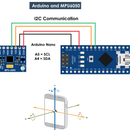Introduction: Atmega32 Mini Development Board Hand Made
To implement any project we have some space constraints. So keeping in mind I made a small handy board.
I am using in robot, fan regulator, etc and many places whenever it needed.
Atmega32 IC Details:
• High-performance, Low-power AVR® 8-bit Microcontroller
• Advanced RISC Architecture – 131 Powerful Instructions – Most Single-clock Cycle Execution – 32 × 8 General Purpose Working Registers – Fully Static Operation – Up to 16 MIPS Throughput at 16 MHz – On-chip 2-cycle Multiplier • High Endurance Non-volatile Memory segments – 32 Kbytes of In-System Self-programmable Flash program memory – 1024 Bytes EEPROM – 2 Kbytes Internal SRAM – Write/Erase Cycles: 10,000 Flash/100,000 EEPROM – Data retention: 20 years at 85°C/100 years at 25°C(1) – Optional Boot Code Section with Independent Lock Bits In-System Programming by On-chip Boot Program True Read-While-Write Operation – Programming Lock for Software Security • JTAG (IEEE std. 1149.1 Compliant) Interface – Boundary-scan Capabilities According to the JTAG Standard – Extensive On-chip Debug Support – Programming of Flash, EEPROM, Fuses, and Lock Bits through the JTAG Interface • Peripheral Features – Two 8-bit Timer/Counters with Separate Prescalers and Compare Modes – One 16-bit Timer/Counter with Separate Prescaler, Compare Mode, and Capture Mode – Real Time Counter with Separate Oscillator – Four PWM Channels – 8-channel, 10-bit ADC 8 Single-ended Channels 7 Differential Channels in TQFP Package Only 2 Differential Channels with Programmable Gain at 1x, 10x, or 200x – Byte-oriented Two-wire Serial Interface – Programmable Serial USART – Master/Slave SPI Serial Interface – Programmable Watchdog Timer with Separate On-chip Oscillator – On-chip Analog Comparator • Special Microcontroller Features – Power-on Reset and Programmable Brown-out Detection – Internal Calibrated RC Oscillator – External and Internal Interrupt Sources – Six Sleep Modes: Idle, ADC Noise Reduction, Power-save, Power-down, Standby and Extended Standby • I/O and Packages – 32 Programmable I/O Lines – 40-pin PDIP, 44-lead TQFP, and 44-pad QFN/MLF • Operating Voltages – 2.7V - 5.5V for ATmega32L – 4.5V - 5.5V for ATmega32 • Speed Grades – 0 - 8 MHz for ATmega32L – 0 - 16 MHz for ATmega32 • Power Consumption at 1 MHz, 3V, 25°C for ATmega32L – Active: 1.1 mA – Idle Mode: 0.35 mA – Power-down Mode: < 1 μA
Step 1: Components Required for Making the Board
most basic things are:
_------------------------------------------------
1) vero board
2) soldering material/wire
3) soldering iron
4) DC socket
5) ic 7805 for 12v to 5v dropping
6) 40 pin ic socket
7) Ceramic capacitor (non-polar) 22pf
8) 100mf/16v capacitor
9) 10 pin socket
10) led red or green
11) BERG STRIP EXTENSIONS for PORT
12) DC WIRE for connection
13) buzzer (5v) optional
14) .1mf ceramic capacitor
15) 330Ohms resistance
Step 2: Circuit Diagram
I have used internal Oscillator(8 MHz max.).
For Atmega32 Datasheet [Click] here.
For all other connection refer circuit diagram given above....




